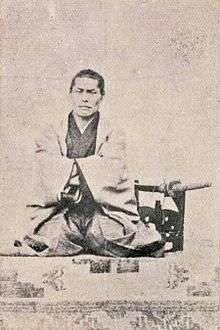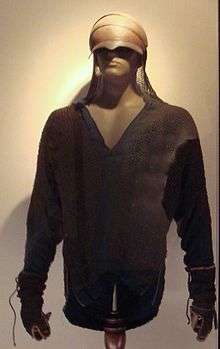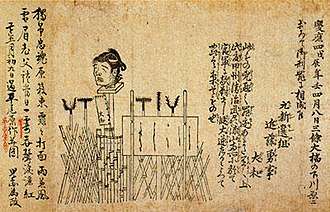Kondō Isami
Kondō Isami (近藤 勇, November 9, 1834 – May 17, 1868) was a Japanese swordsman and official of the late Edo period. He was the fourth generation master of Tennen Rishin-ryū and was famed for his role as commander of the Shinsengumi.
Kondō Isami | |
|---|---|
近藤 勇 | |
 Kondō Isami (1834–1868) | |
| Shinsengumi Commander | |
| In office 1863–1868 | |
| Preceded by | none (Briefly, office held jointly with Serizawa Kamo and Niimi Nishiki) |
| Personal details | |
| Born | Miyagawa Katsugorō November 9, 1834 Kamiishihara Village, Musashi Province, Japan |
| Died | May 17, 1868 (aged 33) Itabashi execution grounds, Itabashi, Edo, Japan |
| Cause of death | Decapitation |
| Resting place | body: Ryugenji Temple, Osawa, Mitaka, Tokyo, Japan head: Hozoji Temple, Okazaki, Aichi Prefecture, Japan |
| Nationality | Japanese |
| Spouse(s) | Matsui Otsune ( m. 1860–1868) |
| Domestic partner | Miyuki Oko |
| Relations | Kondō Shūsuke (adoptive father) Kondō Fude (adoptive mother) Kondō Hisatarō (grandson) |
| Children |
|
| Mother | Miyagawa Miyo |
| Father | Miyagawa Hisajirō |
| Relatives | Miyagawa Rie (sister) Miyagawa Otogorō (brother) Miyagawa Sōbei (brother) Kondō Yūgorō (nephew) |
| Known for | Commander of Shinsengumi |
| Other names | Shimazaki Katsuta Shimazaki Isami Fujiwara no Yoshitake |
| Alias | Okubo Tsuyoshi Okubo Yamato |
| Military service | |
| Allegiance | Tokugawa bakufu |
| Branch/service | Rōshigumi (former) Mibu Rōshigumi (former) Shinsengumi |
| Years of service | 1863–1868 |
| Rank | Wakadoshiyori |
| Commands | Mibu Rōshigumi (former) Shinsengumi |
| Battles/wars | Ikedaya incident Kinmon incident Boshin War |
Background
He was born Miyagawa Katsugorō to a farmer Miyagawa Hisajirō and his wife Miyo[1] in Kami-Ishihara village in Musashi Province (present city of Chōfu) in Western Tokyo on November 9, 1834.[2] He had two older brothers, Otojirō (音次郎; later known as Otogorō 音五郎) and Kumezō (粂蔵; later known as Sōbei 惣兵衛) and an older sister Rie (リエ), who died two years before he was born.[3] Katsugorō began training at the Shieikan (the main dojo of the Tennen Rishin-ryū) in 1848.[4]

As a young man he was said to be an avid reader, and especially liked the stories of the Forty-seven rōnin and the Romance of the Three Kingdoms.[5] His renown as a scholar and his fame at having defeated a group of thieves who tried to break into his family home was great, and caught the attention of Kondō Shūsuke, the third generation master of the Tennen Rishin-ryū.[6] Shūsuke wasted no time in adopting the young Katsugorō in 1849, who first took the name of Shimazaki Katsuta (島崎勝太).[7] According to a record in the possession of the former Gozu-tennōsha Shrine 牛頭天王社 (now the Hino Yasaka-jinja Shrine 日野八坂神社), Katsuta is listed, with full common name and formal name, as Shimazaki Isami Fujiwara (no) Yoshitake (島崎勇藤原義武), and thus, had the name Isami (勇) as of 1858, the document's date.[8]
Kondō was said to have owned a katana called "Kotetsu" (虎徹), the work of the 17th century swordsmith Nagasone Kotetsu. However, the authenticity of his "Kotetsu" is highly debatable. According to Yasu Kizu's pamphlet on the swordmaker Kotetsu, Kondō's sword may actually have been made by Minamoto no Kiyomaro, a swordmaker of high repute roughly contemporary to Kondō.[9]
Kondō married Matsui Otsune in 1860.[10] This was an advantageous match for Kondō as Otsune was the daughter of Matsui Yasogorō (松井八十五郎), a retainer to the Shimizu-Tokugawa clan.[11] On September 30, 1861,[12] Isami became the fourth generation master (sōke no yondai me 宗家四代目) of Tennen Rishin-ryū, assuming the name Kondō Isami and taking charge of the Shieikan.[13] A year later, his daughter Kondō Tama (1862–1886) was born.[14]

Although he was never employed by the Shogunate before his Shinsengumi days, Kondō was a candidate for a teaching position at the Kōbusho in 1862.[15] The Kobusho was an exclusive military training school, primarily for the use of the shogunal retainers, set up by the Shogunate in 1855 in order to reform the military system after the arrival of Perry's Black Ships.[16]
Shinsengumi period
In 1863, the Tokugawa shogunate organized a massive group of rōnin for the purpose of protecting the shōgun Iemochi during his time in Kyoto.[17] Kondō joined the unit, which became known as the Rōshigumi, with his close friend Hijikata Toshizō, as well as Shieikan's members and guests Yamanami Keisuke, Okita Sōji, Harada Sanosuke, Nagakura Shinpachi, Tōdō Heisuke, and Inoue Genzaburō. After the de facto commander Kiyokawa Hachirō revealed their true purpose as being Imperial supporters, the Rōshigumi was disbanded and most of the members returned to Edo. Kondō, Hijikata, former Mito retainer Serizawa Kamo, and a handful of others remained in Kyoto and formed the Mibu Rōshigumi.[18] Acting under the direct orders of the shogunate,[19] Matsudaira Katamori of Aizu undertook supervision of these men. Under the oversight of Aizu, acting in its role as Protector of Kyoto, they worked as police in the imperial capital.[20]
On August 18, his unit was given the name Shinsengumi.[21] In July 1864, the Shinsengumi became well known for arresting a cell of shishi (the incident was known as the Ikedaya Jiken, or Ikedaya Affair).[22]
Kondō later had at least two concubines (or mistresses) in Kyoto, Miyuki and Oko, who were both geishas, with the latter had an illegitimate daughter with him named Oyu, who would later become a geisha as well at Gion.
On July 10, 1867,[23] Kondō became a hatamoto, along with the rest of the Shinsengumi.[24]
Boshin War


After the Battle of Toba–Fushimi where he suffered a gunshot wound in January 1868, he returned to Edo, where he met with the military commander Katsu Kaishū and was promoted to the rank of wakadoshiyori (wakadoshiyori-kaku 若年寄格) in the rapidly disintegrating Tokugawa administration.[25] Kondō created a unit Kōyō Chinbutai (甲陽鎮撫隊, Pacification Corps) (basically the renamed Shinsengumi) based on the surviving remnants of the Shinsengumi and led the unit under the alias of Okubo Tsuyoshi, and they departed from Edo for Kōfu Castle on March 24 on orders to suppress uprisings there. But upon receiving news on March 28 that the Kōfu Castle was taken by Imperial Court forces led by Itagaki Taisuke, they settled at a town of Katsunuma five miles east of Kōfu.
On March 29, 1868, he and his unit resisted an attack by the Imperial at the Battle of Kōshū-Katsunuma for about two hours but lost, and they narrowly escaped from the battle and retreated to Edo.
On April 11, 1868, Kondō, Hijikata and their unit departed Edo again and later set up a temporary headquarters at the Kaneko family estate, northeast of Edo. Kondō later changed his alias from Okubo Tsuyoshi to Okubo Yamato.
Later on April 25, 1868, they moved to a new headquarters in Nagareyama.
Execution
During the training at Nagareyama on April 26, 1868, Kondo and his unit were caught by surprise by the 200 strong Imperial forces, with the Vice-chief of Staff Arima Tota of Satsuma Domain who suspected that "Okubo Yamato" was Kondō himself, ordered him to go with them to their camp at Koshigaya and was later brought to Itabashi on April 27, 1868 for questioning. On the same day Hijikata went to Edo to see Katsu Kaishū and asked for his help in getting a pardon for Kondō. On the following day, April 28, a messenger arrived at Itabashi with a letter seemingly written by Katsu requesting that Kondō's life to be spared, but the messenger was arrested and the request was denied.
Following his trial at which he was declared guilty on April 30, 1868, Kondō was beheaded by the executioner Yokokura Kisoji at the Itabashi execution grounds on May 17, 1868.[26] His execution was also witnessed by his nephew Miyagawa Yūgorō. Kondō's head was put on a pike for public display.
Three days later on May 20, 1868, his headless body was claimed by his nephew to be taken back to Osawa, Edo to be buried, while Kondō's head was salted and moved to Kyoto, where it was piked at Sanjō Ōhashi.
While on display at the Sanjō Ōhashi, Kondō's head was taken away from the bridge by Saitō Hajime, who would later ask the priest Sonku Giten to hold a memorial service for him. The head was taken by the priest when he moved to Okazaki, Aichi Prefecture, and buried in a small mound behind the Hozoji temple.[27]
According to Tani Tateki (1837–1911) of the Tosa Domain, Kondō was arrested under the alias of Okubo Yamato and executed by the new government (formed mostly by the samurai of the Chōshū han and the Satsuma han) as a direct result of being accused of the murder of Sakamoto Ryōma. Even after ex-Mimawarigumi member Imai Nobuo's confession in 1870, Tani insisted that Kondō was not falsely accused for Sakamoto's murder. (Even though the most accepted theory is that the mastermind of the assassination was Sasaki Tadasaburō of the Mimawarigumi, officially, it is still a mystery.)
Grave memorials
Kondō had at least 4 grave sites; it is believed that the first of them was the grave erected at Ten'nei-ji Temple (天寧寺) in Aizu by Hijikata Toshizō.[28] Hijikata, who was convalescing nearby from a foot injury sustained at the Battle of Utsunomiya, brought Kondo's hair there and was said to have personally supervised the preparation and construction of the site.[28] Kondō's funerary name, Kanten'inden'junchūseigi-daikōji (貫天院殿純忠誠義大居士) is believed to have been granted by Matsudaira Katamori.[28]
Another grave site was located at an ancient Ryugenji Temple at Osawa, Mitaka, Tokyo where after his execution, his headless body was brought over by his nephew and buried there with his family.
A grave mound containing Kondō's head was located behind the Hozoji temple at Okazaki, Aichi Prefecture, Japan.
Another grave memorial of Kondō and Hijikata was located on the memorial known as Grave of Shinsengumi, in front of Itabashi Station near the location of former Itabashi execution grounds, was erected in 1875 by Nagakura Shinpachi, with the help of the physician Matsumoto Ryōjun and several surviving former Shinsengumi comrades including Saitō Hajime among others.
Legacy
In 1876, his 14-year-old daughter Kondō Tama married his nephew Miyagawa Yūgorō, who succeed him as a fifth generation master of Tennen Rishin-ryū and renamed as Kondō Yūgorō, established his own dojo Hatsuunkan in Kami-ishihara (present day Chōfu, Tokyo). Tama and Yūgorō only child, a son Kondō Hisatarō, was born in 1883. Kondō Tama died three years later in 1886 and Yūgorō was later remarried at least two times.
In 1905, Kondō Hisatarō was killed in action in the Russo-Japanese War at the age of 22, marked the end of the Kondō Isami bloodline.[29]
In fiction
Kondō Isami is often depicted in fiction, across different media, consisting of but not exclusive to television, film, books, anime, and manga.
Kondō Isao from Gintama is roughly based on him. He also appears in the video-game-turned-anime series Hakuouki Shinsengumi Kitan. Kondō also makes appearances in the series Kaze Hikaru and Peacemaker Kurogane, among others. Kondō is briefly mentioned in the anime series Soar High! Isami by the main characters' ancestors who are also members of the Shinsengumi and his namesake, the female protagonist of the series Isami Hanaoka is named and based after him. He is also briefly shown in the anime Golden Kamuy. He is also portrayed by Eiichiro Funakoshi in the video game Ryu ga Gotoku Ishin!, serving as a major character in the plot of the game.
Notes
- Ōishi Manabu 大石学, Shinsengumi: saigo no bushi no jitsuzō 新選組: 最後の武士の実像. (Tokyo: Chuōkōron-shinsha, 2004), p. 21
- Kojima Masataka 小島政孝. Shinsengumi yowa 新選組余話. (Tokyo: Kojima-Shiryōkan 小島資料館, 1991), p. 10
- Ōishi, p. 22
- Shinsengumi dai zenshi 新選組大全史. (Tokyo; Shin Jinbutsu Oraisha, 2003) p. 27; Ōishi, p. 22.
- Kojima, p.14
- Shinsengumi dai zenshi, p. 27
- Kojima, p.95-96.
- Ōishi, p. 22.
- Yasu Kizu, Swordsmith Nagasone Kotetsu Okisato (Hollywood: W.M. Hawley Publications, 1990), p. 9
- Shinsengumi dai zenshi, p.35
- Ōishi, p. 24.
- 27 August, Bunkyū 1 (1861), by the old lunar calendar. See Ōishi, p. 24.
- Shinsengumi dai zenshi, p.27; Ōishi, p. 24.
- Shinsengumi dai zenshi, p.36; Ōishi, p. 24.
- "Kondō Hijikata to Okita no Shinsengumi" 近藤・土方・沖田の新選組. Rekishi Dokuhon, December 2004, p.62.
- G. Cameron Hurst III. Armed martial arts of Japan. (New Haven: Yale University Press, 1998), pp. 148–152.
- Shinsengumi dai zenshi, p. 38
- Kojima, pp. 39–40
- Yamakawa Hiroshi 山川浩. Kyōto Shugoshoku Shimatsu 京都守護職始末. ed. Tōyama Shigeki (Tokyo: Heibonsha, 1966), p. 87
- Shinsengumi dai zenshi, p. 45
- Shinsengumi dai zenshi, pp. 52–53
- Shinsengumi dai zenshi, p. 56–59
- 6-month, 10-day, 1867 by the lunar calendar. See Ōishi, p. 160.
- Ōishi, p. 160.
- "近藤勇 KONDO". www.tamahito.com. Retrieved Apr 30, 2019.
- Kojima, p.91
- "日本吉 - NIPPON-KICHI". nippon-kichi.jp. Retrieved Apr 30, 2019.
- "天寧寺「近藤勇の墓」". www.city.aizuwakamatsu.fukushima.jp. Retrieved Apr 30, 2019.
- Romulus Hillsborough. Shinsengumi: The Shogun's Last Samurai Corps. (North Clarendon: Tuttle Publishing, 2005), p. 183
Further reading
- Kikuchi Akira 菊池明. Shinsengumi 101 no Nazo 新選組101の謎. Tokyo: Shin Jinbutsu Oraisha, 2000.
- Kojima Masataka 小島政孝. Shinsengumi yowa 新選組余話. Tokyo: Kojima-Shiryōkan 小島資料館, 1991
- Ōishi Manabu 大石学. Shinsengumi: saigo no bushi no jitsuzō 新選組: 最後の武士の実像. Tokyo: Chūōkōron-shinsha, 2004.
- Yasu Kizu. Swordsmith Nagasone Kotetsu Okisato. Hollywood: W.M. Hawley Publications, 1990.
- "Kondō Hijikata to Okita no Shinsengumi" 近藤・土方・沖田の新選組. Rekishi Dokuhon, December 2004.
- Shinsengumi dai zenshi 新選組大全史. Tokyo; Shin Jinbutsu Oraisha, 2003. ISBN 4-404-03065-7
- Shinsengumi Jiten 新選組事典. Tokyo: Shin Jinbutsu Oraisha, 1978.